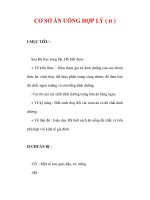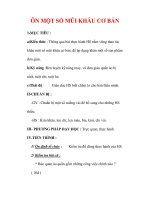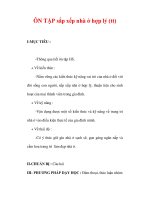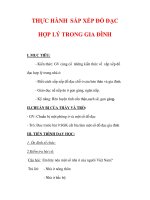BEH sfdg bài giảng địa lý 12 bài 4×bài giảng hóa học 12 bài 4×giáo án công nghệ 12 bài 4×bài giảng địa lý 12 bài 41×bài giảng địa lý 12 bài 43× Từ khóa bài giảng địa lý 12 bài 4bài giảng hóa học 12 bài 4bài giảng công nghệ 12 bài 4giáo án tin học 12 bài
Bạn đang xem bản rút gọn của tài liệu. Xem và tải ngay bản đầy đủ của tài liệu tại đây (77.25 KB, 0 trang )
Behaviourist SLA
Learning and Teaching Foreign Languages
Classroom Illustration
THE AUDIOLINGUAL METHOD
Exercise
Preparation
Work on the Behaviourism-Language unit, particularly
Fries
Lado
pattern practice
audiolingualism
drill
Exercises
Try the three exercises below, using the Audiolingual Method activity to access
the sites cited.
Sample exercises
Download the answer sheet from the same page.
1. Introductory routine
2. A what?
3. Chain drill
4. Learning and evaluating
5. Teaching with the ALM
1/5
Shona WHYTE
unt.unice.fr/uoh/learn_teach_FL
Behaviourist SLA
Learning and Teaching Foreign Languages
Classroom Illustration
1. Introductory routine
Young EFL learners in a French primary school.
Teacher stands in front of a class of learners sitting at their desks. She asks one
learner, 'Amelie, how are you?' The learner responds, 'Fine, how are you?' The teacher
continues, asking different learners, who respond in turn:
Teacher: Vincent, how are you?
Student: Fine, how are you?
Teacher: Helene, how are you?
Student: Fine, how are you?
Teacher: Kevin, how are you?
Student: Fine, how are you?
If a learner is unable to produce the response, the teacher models utterance,
mouthing the syllables first, then aloud if necessary. The teacher also corrects
pronunciation, emphasising the /h/ sound for 'how,' by breathing on her hand in front
of her mouth like a mirror, and eliciting choral repetition from the class when several
learners exhibit the same error. The activity continues until the teacher has asked
each learner and obtained the same response.
Questions
a. What aspects of this activity derive from structural principles?
b. What aspects of this activity are behaviorist?
c. Can we talk about conditioning in these circumstances?
2/5
Shona WHYTE
unt.unice.fr/uoh/learn_teach_FL
Behaviourist SLA
Learning and Teaching Foreign Languages
Classroom Illustration
2. A what?
Young EFL learners in a French primary school.
Teacher and students sit in circle. Teacher explains game in L1. It is a chain game,
where students pass on a new word illustrated on a flashcard, 'a bear,' or pretend not
to understand and ask 'a what?'
First, T shows the flashcard to the first student (S1) and says 'It's a bear.' The first
student says 'a what?' to obtain repetition of the word. The teacher repeats the word
and gives the card to the student. S1 will repeat the word to the next student. S2 will
pretend not to understand, and say 'a what?' S1 will pretend to have forgotten, and
ask the teacher 'a what?' The teacher will repeat 'it's a bear,' S1 will repeat to S2, and
S2 will tell S3 'it's a bear.'
T to S1: ((shows flashcard to S1)) It's a bear.
S1 to T: A what?
T to S1: A bear.
S1 to S2: ((shows flashcard to S2)) A bear
S2 to S1: A what?
S1 to T: A what?
T to S1: A bear.
S1 to S2: A bear
S2 to S3: ((shows flashcard to S2)) A bear
S3 to S2: A what?
Questions
a. What type of activity is described here?
b. Is the activity meaningful or mechanical?
c. After presenting and practising several new animal words, the teacher checks
students' comprehension and memory by presenting 4 flashcards and asking for
volunteers to name the animals. When she points to the bear flashcard, the students
chorus 'a what.'
What has happened here? What are the implications for this approach to learning?
3/5
Shona WHYTE
unt.unice.fr/uoh/learn_teach_FL
Behaviourist SLA
Learning and Teaching Foreign Languages
Classroom Illustration
3. Chain drill
Young EFL learners in a French primary school
Children pass 'who' flashcard round circle, each learner asking Who are you? and
responding I'm _ The chain starts and finishes with the teacher, who models question
and answer, mouthing to cue some students.
Next, learners practice How are you? with a different flashcard, and the response,
Fine, how are you?
The teacher holds up one flashcard and then the other, eliciting the different
questions and answers, and emphasising the difference between the question words
how and who.
Finally, the teacher passes each flashcard round the circle in opposite directions,
requiring learners to ask and answer the appropriate question.
Questions
a. Identify the behavioristic and structural aspects of this activity.
b. What other activities might the teacher use to extend the learning produced in this
context?
4/5
Shona WHYTE
unt.unice.fr/uoh/learn_teach_FL
Behaviourist SLA
Learning and Teaching Foreign Languages
Classroom Illustration
4. Learning and evaluating
Young EFL learners in a French primary school.
Visit Steve Mound’s website for French middle school EFL learners to try his activity
on classroom objects.
/>Questions
a. Devise behaviorist learning activities from this online activity.
b. How can the learners be evaluated without recourse to the written form (which the
audio-lingual method tends to leave until after the aural/oral forms are acquired)?
5. Teaching with the ALM (Audio-Lingual Method)
Thomas Nunally, Department of English, Auburn University, Alabama, US.
/>Read the presentation of different types of drills and try Nunally’s hands-on activity.
5/5
Shona WHYTE
unt.unice.fr/uoh/learn_teach_FL









